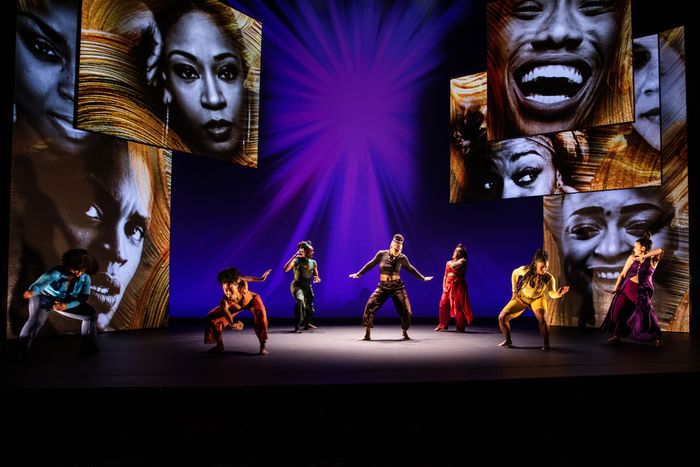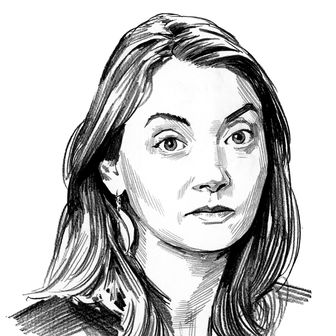
When for colored girls who have considered suicide / when the rainbow is enuf came to Broadway in 1976, it played at the Booth Theatre. Now it returns in triumph, and you can understand why it has gone back to its former home. The Booth is intimate for a Broadway house: The stage is low, almost an extension of the orchestra level, and the sole balcony snuggles in close. Ntozake Shange’s dance-theater theatrical masterpiece — she coined the term choreopoem to describe it — thrives there. Her series of lyrical monologues, delivered by unnamed figures Lady in Red, Lady in Orange, and so forth, were first spoken in feminist reading circles and Bay Area bars. You really do need to experience it in that sort of dark, close place, somewhere you can hear the person two rows over mm-hmming her approval, snapping her fingers, even reciting along.
There’s a slight mystery about the show’s relationship to the well-regarded (and copiously nominated) downtown revival at the Public in 2019. The Public Theater is producing again, and much of the company from that earlier show is still in place — three of the seven performers, half the design team. It’s not a transfer, though; it’s a new production. Crucially, the production’s choreographer, Camille A. Brown, has taken the directing reins from Leah C. Gardiner, and the resulting work feels less like a communal sharing (Gardiner emphasized Shange’s mellow, hangout vibration) and more like a ballet-with-language, lapidary and sculpted. The seven Ladies don’t simply dance, they now move in spectacular ways, particularly the Lady in Brown (Tendayi Kuumba, one of the featured dancers from David Byrne’s just-closed American Utopia) and the Lady in Yellow (D. Woods).
The production embraces a heat-dazed ’70s look and sound. Martha Redbone and Aaron Whitby’s piano-heavy music ambles groovily around, touching every moment with a little stink, a little funk. Sarafina Bush’s costumes tend to involve some cutaway — either over the midriff (as for Kenita R. Miller, who is eight months pregnant) or the clavicle — a kind of pride-in-skin that makes the room glow with summer warmth. Set designer Myung Hee Cho leaves the stage empty while suspending big rectangular screens overhead, which then swirl with abstract galactic images (Aaron Rhyne did the projection design) and fuzzy, pulsing, red-and-black star fields. Rhyne also projects images of the Ladies’ faces or zoomed-in images of paint, the thick ridges still showing the mark of the brush. The paint changes under Jiyoun Chang’s lights. Sometimes it seems gold, other times black.
Examining the pictures that the production made available for this review, it seemed strange to me that they didn’t really resemble what I saw. The pictures make it seem as if the production takes place on an awards-show set, but I didn’t experience it that way at all. There’s a strange perspectival trick in for colored girls, which focuses your attention so tightly on the performers that they loom up in your memory, blotting out the surroundings. For instance, I feel I saw Okwui Okpokwasili drawl her stupendous Lady in Green monologue in close-up, but of course she was thirty feet away, on a stage.
somebody almost walked off wid alla my stuff
not my poems or a dance I gave up in the street
but somebody almost walked off wid alla my stuff
like a kleptomaniac workin hard & forgettin while stealin
this is mine / this aint yr stuff
Even if you have never seen for colored girls, you’ll get a sense that you’re seeing a beloved and much-handled classic. The other Ladies murmur “alla my stuff, alla my stuff” in anticipation as Okpokwasili slides center stage to perform the aria; it’s like watching an arena chant for a favorite song. There are a few contemporary touches — the Lady in Orange (Amara Granderson) does a slyly recognizable imitation at one point — but for the most part, the show seems as unchanging as a jewel, dug up already shining.
In a 1979 interview about what makes a poet, Shange said it came down to “a very conscious effort to be concise and powerful and as illusory as possible, so that the language can … bring you to more conclusions than the one in the poem.” The conclusions in her poems include touch as a healing quality, Black and brown women’s proximity to danger, and a defiant reclamation of sensuality. The Ladies talk about existential loneliness (“bein alive & bein a woman & bein colored is a metaphysical dilemma / I havent conquered yet”) and the sheer effort of continuing to love in the face of violence. They tell tales, sometimes raucously, sometimes with a tender concern. Men do not handle them gently, though they often handle men for their own delight. “By daybreak / I just cdnt stop grinning,” shouts the Lady in Yellow about losing her virginity, and women constantly appear as goddesses, prayed to by dazzled and lustful lovers.
The conclusions that the poems lead to, though, are even more mystical. They have to do with the uplifting energies of women turning to each other and meeting each other’s eyes, as they do after the Lady in Purple’s section (Alexandria Wailes), conducted partly in American Sign Language, or when the Lady in Blue (Stacey Sargeant) performs a shattering monologue, and the Lady in Brown dances for, or more precisely, as her. Brown is one of our finest choreographers, and she is turning her movement-mind to the way women’s bodies carve and take up space — particularly the way these arrangements can actually make weight easier to bear.
And there is a lot of weight to carry. Shange’s most uncompromising section comes late in the evening, when Miller’s Lady in Red tells a story about the abusive Beau Willie Brown. Beau comes for his girlfriend Crystal when he’s out of his mind with drugs, and Shange’s tale moves so quickly, it’s like the attack actually happens in front of you. For the duration, Brown leaves Miller alone onstage, unaccompanied and blazing like a bonfire. But then, thank God, she brings the women back. Brown has them mass into a phalanx — there are only seven women, but they often seem like more — and they whirl Miller back into their company. Not to get too mystical about it, but this impeccably performed, exquisitely choreographed revival manages the same for many of us out there in the dark. Dance, said Shange, allowed her to understand the planet the way “atomic particles experience space.” If that’s so, then atomic particles must love each other wildly. They must always be so grateful to see each other, whenever gravity — or a revival — draws them back into one another’s arms.
for colored girls who have considered suicide / when the rainbow is enuf is at the Booth Theatre.


